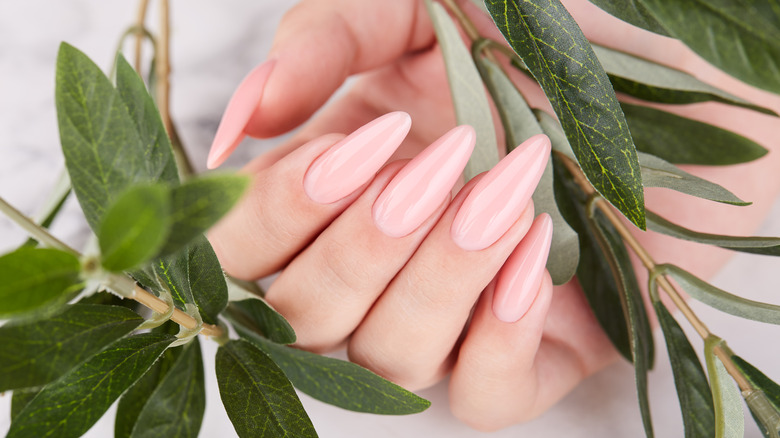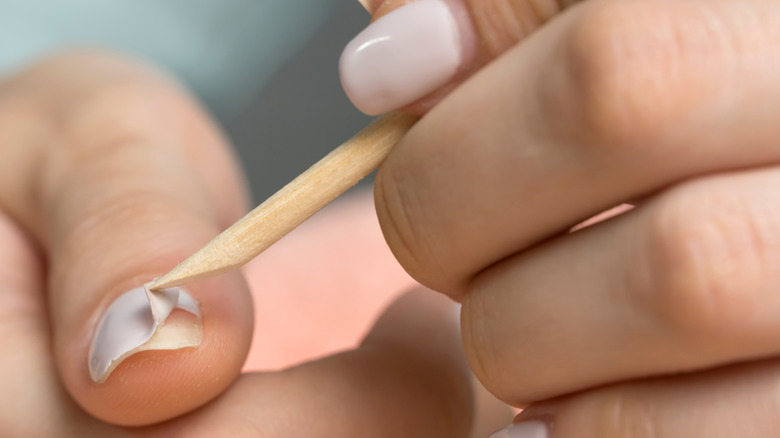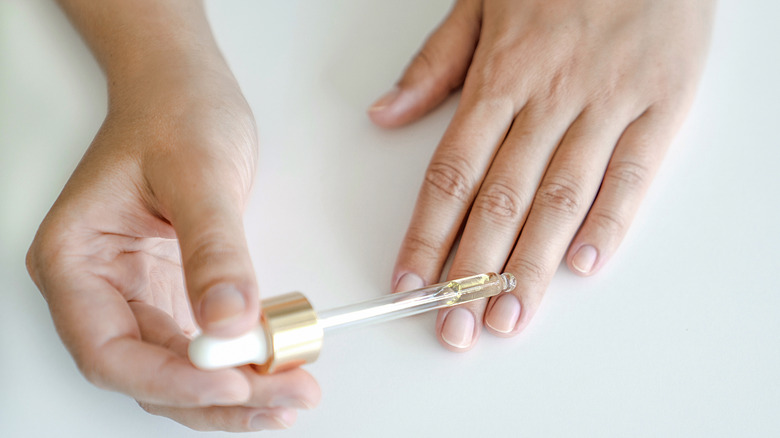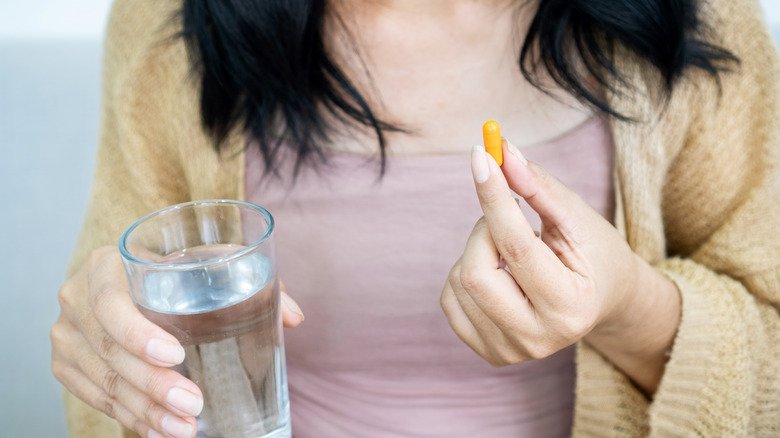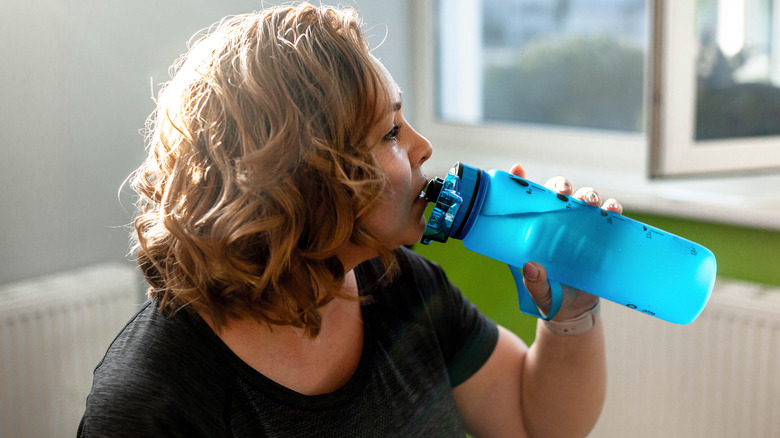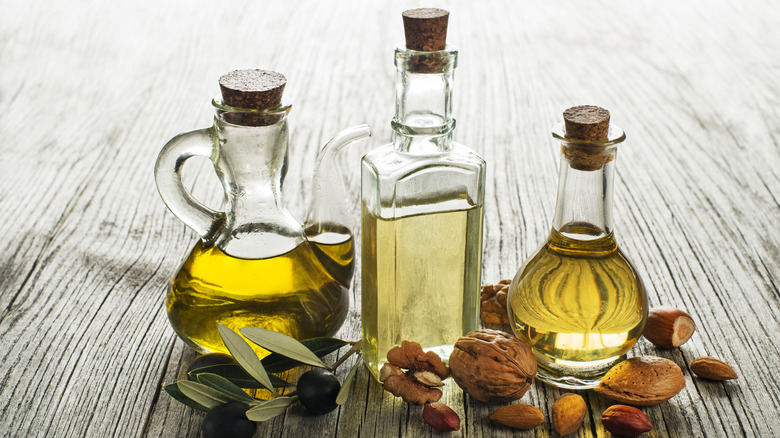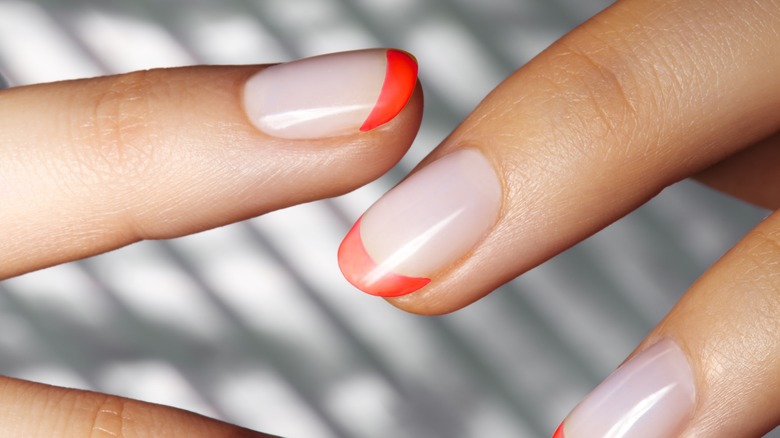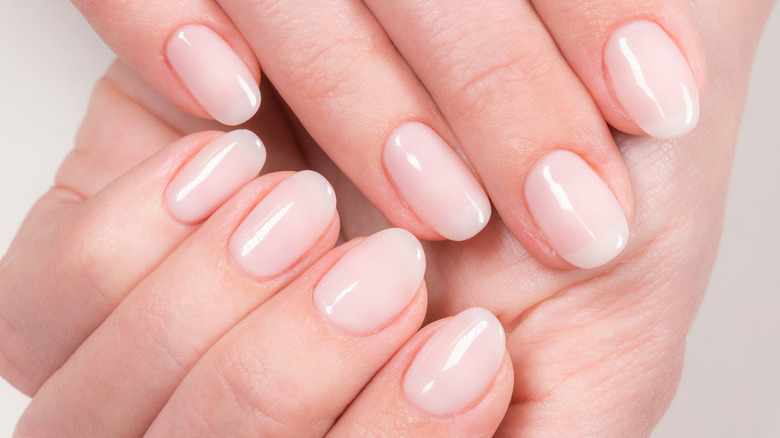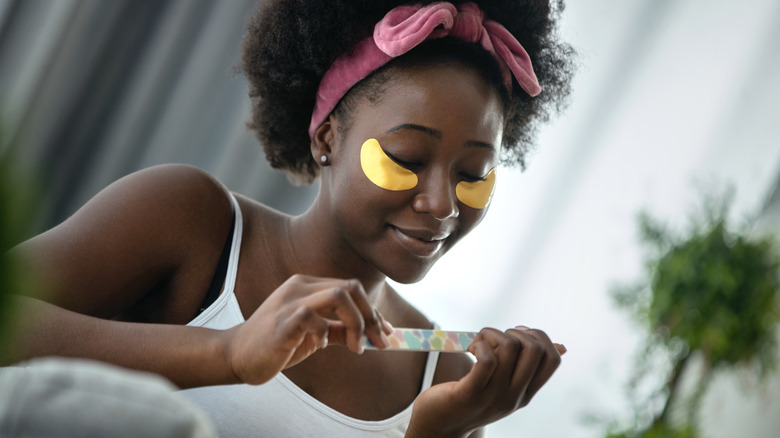How To Revive Your Nails After A Bad Gel Manicure
A gel manicure is a step up from regular nail polish. It adds strength to your natural nails without applying tips and acrylic, although it can also be used over acrylic or hard gel nails. Gel is better than regular polish because it goes through a three-step process that prevents it from smudging and makes it last longer on your nails. A base coat is first applied, then a few layers of gel polish, and finally, the top coat. After each layer is painted on, your nails are cured under a UV lamp for 30 seconds to two minutes so that the nails can dry.
While a gel manicure makes your natural nails stronger after it's applied, it'll actually make them weaker once removed. This can be an even bigger problem if the gel isn't taken off correctly. After about 14 days, your manicure will start chipping. If you're tempted to peel it off, your nails can become thin and weak. They may even get white spots, white lines, and become uneven. And these problems won't go away until your nails grow out.
However, you can revive your nails after a bad gel manicure with these tips.
Remove the gel correctly
Removing your gel nails correctly is the first step to ensuring your natural nails will be healthy enough to revive. If you try to peel off the gel, you can risk taking off part of your natural nails with it. Not only will this leave you with uneven nails, but it can hurt if they get too short. Even though your nails may look okay after you improperly remove the gel, they are very damaged. This is because the naked eye can't see the damage you're doing to your nail plate. Ripping it off pulls apart the layers of your nail, making them brittle and dry.
The proper way to remove your gel manicure is simple but time-consuming. First, you need to file the top coat off your nails. The salon usually uses a nail dremel, but a regular file will complete the job at home. Then soak some cotton balls in acetone and keep them on your nails with tin foil or plastic wrap. Every formula is different, so periodically check how easy it is to remove the polish. If it's not budging, leave it to soak for longer. You should be able to use a cuticle stick to scrape it off your nails without much effort.
Use cuticle oil
A bad gel manicure doesn't just wreak havoc on your nails — it can also do some major damage to your cuticles. The polish can be rough on the nail's surface, and the UV lamp used to cure the polish can dry out the skin, leading to hard or cracked skin, hangnails, inflammation, and potential infections.
Enter cuticle oil, a hydrating and vitamin-rich product made primarily from fruit, nut, and vegetable oils. As its name suggests, cuticle oil is useful for restoring dry, cracked, or peeling cuticles. Cuticle oils made of jojoba, coconut, avocado, and argan oils are bursting with skin-healthy ingredients and antioxidants. These oils are thin and typically non-greasy, meaning that they're easily absorbed into the skin. "People often go to use cuticle oil when they're experiencing very dry or cracked cuticles, or they're noticing dehydration," the co-founder and head of product at nail essentials brand Tenoverten, Jaclyn Ferber, shares with Women's Health. "But using it regularly is beneficial in overall nail health, period." It can add shine to a regular polish manicure, promote blood flow to the nails and skin, and boost hydration.
"There are several different applicators that cuticle oil can come with," celebrity manicurist Michelle Saunders tells Byrdie. "It's ideally applied to each cuticle on each finger and rubbed in, and is recommended after each hand washing but could also be applied as often as you like." If applying cuticle oil several times a day doesn't work with your lifestyle, simply aim for it twice a day.
Use a nail strengthening treatment
Cuticle oils are a necessary step in boosting the strength and hydration of your nails post-manicure, but additional strengthening treatments can take your nail game to the next level. Keratin treatments are particularly effective for repairing nails damaged by recurring gel manicures. According to Cleveland Clinic, keratin — essential proteins that naturally make up the structure of hair, skin, and nails — can be applied at a salon or at home to increase the strength of weak or brittle nails. "Adding a keratin protein to your nail care can immensely help improve the condition of damaged nails," notes nail expert Sherrille Riley in an interview with Refinery29.
Some evidence suggests that introducing a biotin supplement into your daily routine may also help strengthen your nails. While it is a needed vitamin for a healthy body and a healthy gut, "biotin is, in fact, an essential nutrient for healthy skin, hair, and nails," Dr. Frieling shares with Shape. Healthline notes that egg yolks, spinach, almonds, and sweet potatoes are biotin-rich food sources that can help strengthen and support strong nails in lieu of a supplement. If these treatments aren't in your budget, consider investing in a nail hardener polish. Although these products are not the same thing as a nail strengthener, they are a short-term solution for hardening the nail plate. "Nail hardeners work by binding the keratin protein in your nails more tightly and hardening your nail plates, making them less flexible," nail expert Queenie Nguyen tells InStyle.
Take collagen supplements
Some research suggests that a collagen supplement may also support strong nails. Collagen is a protein naturally produced in the body, similar to keratin. It is vital for strong bones, muscles, joints, cartilage, and tissues, and is also thought to be responsible for maintaining skin elasticity as you age. It is also found in nail beds and is one of the building blocks of fingernails.
Collagen can be obtained primarily via food sources like red meat, bone broth, and fish skin, but collagen supplements may prove beneficial for nail health, particularly or women who don't eat meat. A small 2017 study found that individuals who took a daily dose of 2.5g of bioactive collagen peptides for five weeks saw a 42% decrease in broken nails, with 80% of the study's participants agreeing that their nail's look and feel had improved post-treatment. While more studies are needed to conclusively prove that consuming collagen in the form of pills or liquid supplements will improve nail health, a supplement containing collagen and hyaluronic acid may reduce peeling, cracking, and brittleness caused by gel manicures.
Stay hydrated
If you want to repair your nails fast, now might be a good time to invest in an emotional support water bottle. "Drinking enough water is essential for health, and nail health is no exception," board-certified dermatologist Sheel Desai Solomon, M.D. explains to Prevention. "Without adequate moisture, nails can be come brittle and break or peel easily."
Gel nail polish and the UV light lamps used to cure it are dehydrating for the nail plates and cuticles. However, the prevalent use of the harsh chemical acetone in gel manicures is, by nature, dehydrating. Acetone is used by many manicurists to remove old polish and nail oils prior to painting on new polish, stripping the nail's surface of needed nutrients and moisturizing agents. It also dissolves the keratin present in the nail. While the regular use of these products will naturally have dehydrating effects on the nails, remaining hydrated can help counteract some of the moisture loss that makes nails weak. The amount of water you need to drink depends on a variety of factors, including where you live and your activity level. Generally, an adult woman should aim for 11.5 cups or 2.7 liters of water per day, per Mayo Clinic.
Consider an almond or olive oil soak
Gel manicures are a lovely treat, but too many in a row will leave your nails begging for rejuvenation. If you're in need of a luxurious but inexpensive DIY nail treatment, you needn't look further than your kitchen pantry. Soaking your nails for 10 to 15 minutes in a bowl of nutrient-rich, warm almond or olive oil is all you need to help reverse manicure damage. "Particularly with the discussion of brittle nails, management does involve using moisturizing oils to improve splitting of the nail plate and improving nail quality," Rachel Nazarian, M.D., F.A.A.D. tells Shape.
Olive and almond oils act as conditioners for brittle, weak nails. Olive oil is rich in fatty acids and antioxidants that protect the nail and shore it up, while almond oil is rich in vitamins A and E. Both have the ability to penetrate the nail and skin, softening the texture of rough or cracked skin and providing needed moisture that can slow signs of aging. This at-home treatment has moisturizing benefits for the rest of your skin as well. "Your cuticle is the end of your skin and is meant to be a barrier to keep bacteria and free radicals from entering the body, preventing infections," celebrity manicurist Deborah Lippmann explains in an interview with Byrdie. "Keeping your cuticle moisturized helps to keep it healthy and healthy cuticles are key to healthy nail growth." Aim for a daily soak for best, and fastest, results.
Keep your nails short
You may notice that your nails are softer than normal after a bad gel manicure, particularly if you've succumbed to the urge to pick off the polish. As soft, weak nails are more prone to breakage, now is really not a good time to try and grow out some glorious talons. "To prevent your nails from breaking, which can be quite painful, you should keep them very short until they recover," manicurist Madeline Poole tells Allure.
Proper trimming technique is important to avoid harming your nails further, as well as ingrown nails or infection. Use disinfected clippers or nail scissors to trim your nails, taking care to cut straight across. The American Academy of Dermatology recommends using an emery board to file the corners of your nails in a slightly rounded shape. In addition to clipping your nails regularly, gently filing your nails two to three times a week is a great way to shore them up and keep them strong. Always start from the outsides of the nail and work your way toward the center when filing, moving in short, slow motions to avoid filing them down too far. Never saw back and forth, as this can cause the nails to fray further and increase the likelihood of peeling or breakage.
Opt for a rounded shape
What's popular in the nail world is constantly changing. And although the square nail shape is trending for fall 2023, if you're trying to grow and strengthen your nails, you may want to opt for a rounded nail shape for the time being. Why? Because nails with straight or tapered edges — like coffin-shaped or square-shaped nails — have sharp corners that can easily get caught on or snag on things like clothes or hair. Short, rounded nails are the strongest, most durable shape.
Going for a more conservative nail shape doesn't take you out of the running for trendy nails, as nail expert Sarah Gibson Tuttle explains to Makeup.com. "Think round, oval, squoval or even almond," Tuttle says. "Round and squoval nails are most resistant to breakage because there are no sharp edges that can cause weak points in the nail." Oval nails are not only a good look for most people, they have a lengthening effect on the hands and fingers. Squoval nails are particularly complementary for a variety of finger shapes and sizes. The square nail shape offers plenty of strength in the nail bed while the gentle slope of the oval at the top of the nail offers a soft sophistication suitable to any fashion-forward look.
Take a break from gel
The best thing you can do for nails damaged by gel manicures is simply to take a break from the nail salon altogether. "Nails do not need to 'breathe,'" dermatologist Dr. Dana Stern told Bravo. "This is a myth! Nails receive their nutrients, oxygen, and blood supply from the blood stream and not from the air." However, that doesn't mean they won't benefit from a break. "I know people don't like to hear it, but the more time off from gels and acrylics, the better the health of your nails," editorial manicurist Jin Soon Choi tells Who What Wear. Going polish-free for a few weeks is a commitment but one that will pay off big time in the long run.
If the thought of going au natural with your nails is just too much to bear, take it back to basics with a no frills, at-home nail routine. "If one really can't go without their normal nail-care regimen, I recommend a clear nail polish, just to observe one's nail growth situation," salon founder Amy Ling Lin shares with InStyle. A natural, bare manicure complete with regular trims and filing a couple times a week will help you transition your damaged nails from weak and brittle to tough and beautiful in no time.
